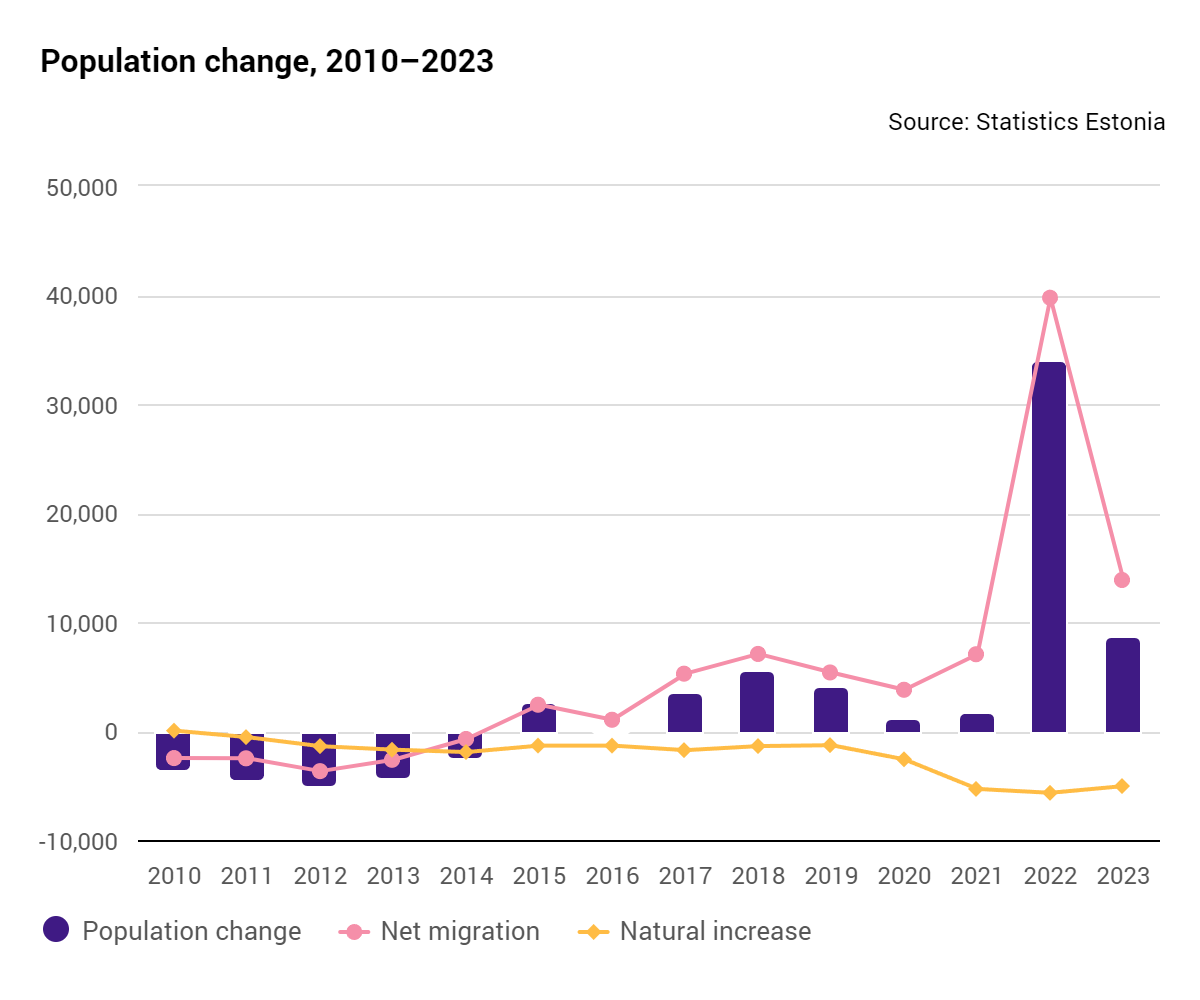Estonia's population is increasing due to Ukrainian immigration
According to Statistics Estonia, on 1 January 2024, the population of Estonia was 1,374,687. There were 10,949 births and 16,002 deaths in Estonia in 2023.
Terje Trasberg, team lead of population and education statistics at Statistics Estonia, said that 26,399 persons immigrated to Estonia and 12,543 persons emigrated.
“Natural increase was negative (-5,053 people), while net migration was positive (+13,856 people). Estonia's population grew by 8,803 people in a year,” she noted, adding that last year was unfortunately characterised by an exceptionally low number of births – just under 11,000 babies were born.
Ukrainians make up 4.4% of the population
According to the analyst, for the second year in a row, population growth was driven mostly by Ukrainians arriving in Estonia. Half of all immigrants were of Ukrainian citizenship, of whom 13,082 remained permanently in Estonia. Year on year, the number of immigrants with Ukrainian citizenship fell by two and a half times.
“Last year, 12,543 people left Estonia, 1,643 of them Ukrainian citizens. At the beginning of 2024, there were 60,414 people of Ukrainian citizenship living in Estonia, accounting for 4.4% of the population. 44,480 of them, or three quarters (73%), have arrived in Estonia since the beginning of 2022,” she said.
Number of births fell further
10,949 babies were born in 2023, which is 697 fewer than the year before. This marks the lowest number of births recorded in Estonian population statistics.
“The number of births, which has been falling for several years in a row, is above all a reflection of the prevailing mood in society. Uncertainty about the future, caused by both the economic downturn and the war in Ukraine, is discouraging families from having children,” explained Trasberg, adding that birth rates have declined in almost all European countries in recent years.
Fewer first, second and third children were born
First children account for 40% of all births, second children for 34% and third children for 18%. Last year, the average age of women giving birth was 31 years, compared with 29 for first-time mothers.
“The average age of first-time mothers has increased by one year in the last 5 years. Of the women who gave birth last year, 86% were of Estonian citizenship, 5% of Ukrainian and 3% of Russian citizenship,” the analyst stated.
There were 16,002 deaths in 2023. “Last year's number of deaths was down by 1,313 from the year before last, and down by 2,585 from 2021, when the number peaked in pandemic years. The number of deaths in 2023 fell back to the 2010–2019 average,” said Trasberg.
More people arrived than left the country
In 2023, there were 5,758 Estonian citizens arriving in the country and 5,511 leaving, i.e. the number of arrivals exceeded the number of departures by 247. Among the citizens of other countries, the highest number of arrivals were of Ukrainian citizenship.
“There was a significant drop in both immigration and emigration of Russian citizens. Net migration of Russian citizens decreased from 1,335 in 2022 to 424. Foreign EU citizens account for 11% of total immigration,” the analyst pointed out.
The highest emigration from Estonia continues to be to Finland, with 2,487 people heading towards that country. 2,514 people arrived in Estonia from Finland. In terms of European Union member states, there were more leavers than arrivals – 5,276 people moved from Estonia to another EU country and 4,969 people arrived from another EU country.
Data on Ukrainians
The data on migration published here cover persons who have settled permanently in Estonia (immigration) or lived permanently in Estonia before emigrating. The number of emigrants does not include war refugees who were in transit in Estonia. In Estonia, data on Ukrainian war refugees are also collected by the Police and Border Guard Board, who publish the number of persons applying for temporary protection. Persons who have been granted temporary protection are included in the preliminary population figure only if they have settled permanently in Estonia.
Eurostat fertility rate data for 2022
More detailed data have been published in the statistical database.
See also the population section on our website.
Information on the data sources and methodologies used in population statistics is available in the methodology section.
When using Statistics Estonia’s data and graphs, please indicate the source.
For further information:
Heidi Kukk
Media Relations Manager
Marketing and Dissemination Department
Statistics Estonia
Tel +372 625 9181
press [at] stat.ee (press[at]stat[dot]ee)
